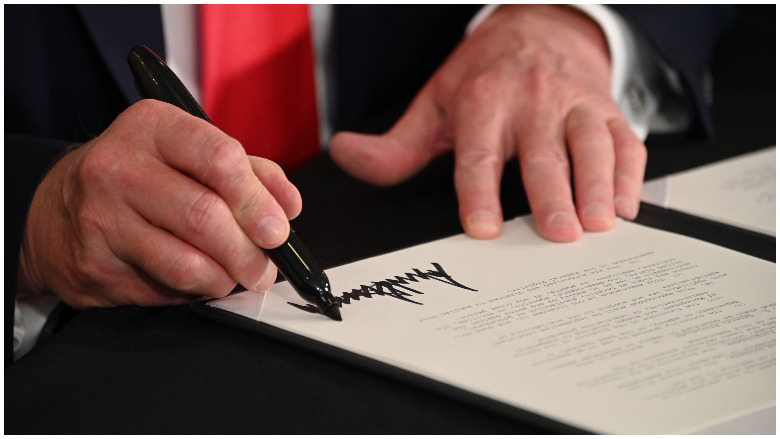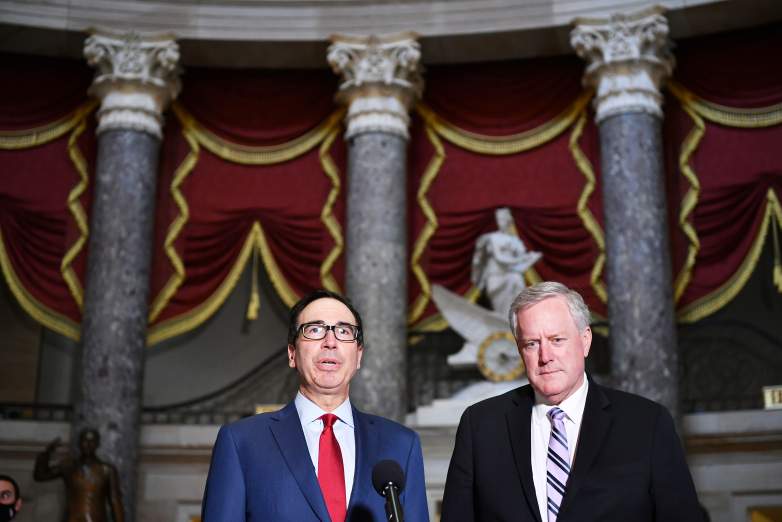
Getty President Donald Trump signs executive orders on economic relief on August 8, 2020.
Donald Trump held a press conference from his golf club in Bedminster, New Jersey, on August 8 to announce that he was signing multiple executive orders on economic relief after negotiations in Congress failed to reach an agreement on the next COVID-19 response bill.
The president said during a news conference the day before that “if Democrats continue to hold this critical relief hostage I will act under my authority as president to get Americans the relief they need.” On Saturday, Trump signed a series of four executive orders: a payroll tax holiday for some Americans, an additional $400 a week in extended unemployment benefits, eviction moratoriums and the deferment of student loan payments, NBC News reported.
Trump’s executive orders on a new coronavirus stimulus package were championed by White House economic adviser Larry Kudlow. The question remains, does the president has the power to enforce his executive orders?
The orders are likely to face legal challenges as serious questions exist about the use of executive power in this fashion.
The Constitution gives Congress authority over federal spending.
Last week, House Democrats promised to file a legal challenge if Trump acted through executive order to bypass Congress.
According to Constitution Daily, “An executive order is a directive from the President that has much of the same power as a federal law.”
According to the American Bar Association, “Executive orders are not legislation; they require no approval from Congress, and Congress cannot simply overturn them. Congress may pass legislation that might make it difficult, or even impossible, to carry out the order, such as removing funding. Only a sitting U.S. President may overturn an existing executive order by issuing another executive order to that effect.”
Here’s what you need to know:
The President’s Economic Adviser Said He Thought the Unemployment Benefits Order Would Require an Act of Congress

GettyTrump signing the stimulus executive orders.
The federal government is funding 75% of the extra unemployment payments, and Trump said states will have to come up with the rest. A journalist asked him if governors had signed on to that and he said, “If they don’t, that’s going to be their problem. I don’t think their people will be too happy. They have the money. The states have the money. It’s sitting there.”
That’s only one question swirling around the executive orders; the bigger question revolves around whether they’re legal. The Washington Post reported that the orders make “dramatic changes to tax and spending policy, signing executive actions that challenge the boundaries of power that separate the White House and Capitol Hill.”
Even some members of Trump’s own administration didn’t think it was all legally possible. Kudlow, the director of the White House National Economic Council, said earlier in the week of extending unemployment benefits, “I don’t think that can be done administratively. I think that requires an act of Congress.”
“The President cannot create new money with an executive order. These EOs simply show the limitations of the President’s legal authority,” said Jack Smalligan, a senior policy fellow at the Urban Institute, to The Post. “The U.S. Constitution gives Congress authority over federal spending,” Reuters reported, indicating that legal challenges are likely.
Trump Said: ‘If We Get Sued, it’s Someone Who Doesn’t Want People to Get Money’
The president said he was not worried about Congress threatening legal action. He told reporters on August 7, “You always get sued.” On Saturday, Trump denied that he expected legal action on this but said, “If we get sued, it’s going to be someone who doesn’t want people to get money. And that’s not going to be a very popular thing,” ABC News reported.
Senate Minority Leader Chuck Schumer said on Friday that the White House team is aware their power is limited.
“The other choice is for them to do executive orders which by their own admission, they said it to us repeatedly is not close to as good,” Schumer said. “It doesn’t cover opening of schools. It doesn’t cover testing. It doesn’t cover dealing with rental assistance. It doesn’t cover elections. It doesn’t cover so many things.”
Schumer and House of Representatives Speaker Nancy Pelosi offered to reduce their proposed $3.4 trillion COVID-19 stimulus package by $1 trillion in order to reach a deal, but White House Chief of Staff Mark Meadows and U.S. Treasury Secretary Steven Mnuchin rejected their offer.
Where Is Trump’s Stimulus Relief Money Coming From?

GettyWhite House Chief of Staff Mark Meadows (right) and US Treasury Secretary Steven Mnuchin at the U.S. Capitol in Washington, D.C., on August 7, 2020.
NewsHour’s White House reporter Meredith Lee said via Twitter that a senior White House official confirmed that Trump will divert unspent money from Federal Emergency Management Agency (FEMA) and the Coronavirus Aid, Relief, and Economic Security (CARES) Act to extend federal unemployment payments.
Lee tweeted, “The UI move will likely be met with legal challenges. Some UI experts think states will have to stand up completely new systems to pay the reprogrammed $ out, which would cause delays. But that’s unclear.”
During his announcement on Saturday, Trump did not specify when money from his economic relief package would start rolling out. However, he did make it clear that the unemployment benefits would include a $400 a-week boost, not the $600 included in the previous stimulus package, which expired in July.
READ NEXT: WATCH: Biden Tells Fox News He’s Decided on Vice Presidential Running Mate
